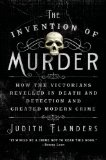Summary | Excerpt | Reviews | Beyond the Book | Readalikes | Genres & Themes | Author Bio

How the Victorians Revelled in Death and Detection and Created Modern Crime
by Judith Flanders
One man, arrested on suspicion, attempted to turn king's evidence, identifying eight men as his fellow murderers. Unable to come up with a motive, the newspapers attributed a love of wholesale slaughter to this mysterious gang. The gang theory was widely popular. A magistrate from the Thames Police Office wrote to his colleague at the Lambeth Street Office that the crime 'gives an appearance of a gang acting on a system', but to what end was not clear. Many were caught up: at one point seven men were held for questioning because 'In the possession of one of them were found two shirts stained with marks very much resembling blood, and a waistcoat carrying also similar marks…' The men turned out to be hop-pickers, and the stains were vine sap.
The first clue that led towards an arrest was noticed only on the day of the Williamsons' murder, twelve days after the death of the Marrs, when it finally registered that the peen maul found in the kitchen had the initials 'JP' scratched on it. A handbill advertised this, and Mrs Vermiloe, the landlady of the Pear Tree Tavern, reported that her lodger, a Danish sailor named John Petersen, had left his tools in her care on his last shore leave. Petersen was at sea at the time of the murders, but his fellow lodger, John Williams, was said to have shaved off his whiskers the following day; furthermore, he had been seen washing his own stockings at the pump in the yard; and both he and another lodger, John Ritchen, knew Petersen. This was enough for an arrest. On 27 December the magistrates' court was packed with eager spectators when the news came that Williams had committed suicide in his cell.
The immediate reaction was that the suicide was an outright confession. Anything that contradicted this comforting notion was pushed to one side. On reflection, the questions greatly outweighed the certainties. It was not even clear that John Williams' name was John Williams – he had told the Vermiloes it was Murphy. Mr Vermiloe, the landlord, had been in prison for debt when his wife directed the police to Williams. The twenty-guinea reward for identifying the maul would pay off at least some of his debts, possibly all of them; how much weight could be given to her evidence? And two men at least had been at the Marrs': the footprints of two men were found, and at least two men had been seen running down the road. Who were they? Vermiloe had used the maul to chop wood, and both it and the ripping chisel that was also found in the Marrs' kitchen had been used as toys by his children in the yard – anyone could have taken them.
None of these questions was asked. Instead everyone agreed that they had long suspected Williams. One witness swore that, three weeks before the Williamsons were murdered, he had seen Williams with 'a long French knife with an ivory handle'. No one else had ever seen that knife and Williams together, but the Gentleman's Magazine reported that on 14 January 1812, miraculously, a lodger at the Pear Tree had found a blue jacket which he said had belonged to Williams, and it was reported that the inside pocket was marked, 'as if a bloodstained hand had been thrust into it'. But bloodstains could not definitely be identified until the twentieth century – what the witness meant was that the stain was brown. Furthermore, no one else had seen Williams wear this jacket, nor was there any discussion about who might have had access to it during the period of the murders, or in the following month. Mrs Vermiloe turned it over to the police, at which point they returned to the Pear Tree, searched the house once more and found a clasp knife, 'apparently dyed with blood', hidden behind a wall. The Edinburgh Annual Register added that a pair of trousers had been found shoved down under the 'soil' in the privy in the Pear Tree yard, which 'are spoken to very confidently by Williams' fellow-lodgers'.
From Invention of Murder by Judith Flanders. Copyright © 2013 by the author and reprinted by permission of St. Martin's Press, LLC
Harvard is the storehouse of knowledge because the freshmen bring so much in and the graduates take so little out.
Click Here to find out who said this, as well as discovering other famous literary quotes!
Your guide toexceptional books
BookBrowse seeks out and recommends the best in contemporary fiction and nonfiction—books that not only engage and entertain but also deepen our understanding of ourselves and the world around us.